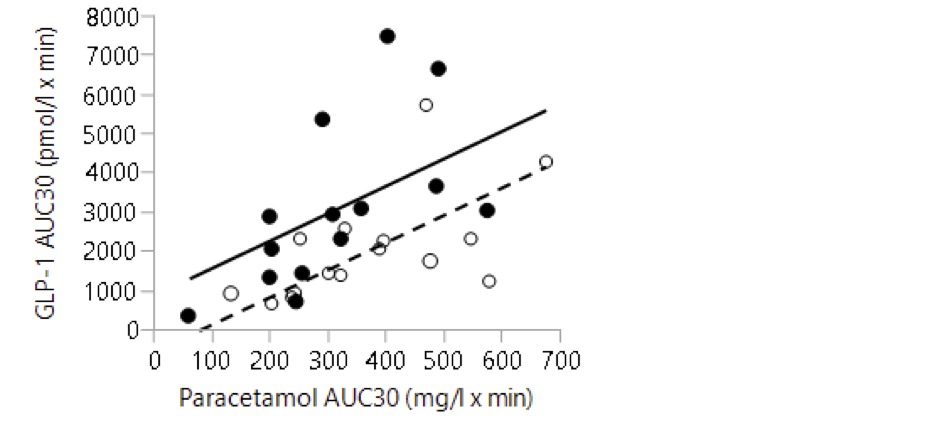|
Back to 2017 Posters
GASTRIC EMPTYING AND MODE OF OPERATION INDEPENDENTLY ENHANCE THE RELEASE OF GLP-1 AFTER A MIXED MEAL AND IMPROVE GLYCEMIC CONTROL IN SUBJECTS HAVING UNDERGONE WHIPPLE'S PROCEDURE AND PYLORUS PRESERVING PANCREATICODUODENECTOMY (PPPD)
Johannes Miholic*1, Emanuel Steiner1, Lukas Kazianka1, Marlene Wewalka1, Birgit Reiter1, Jens Holst2
1Medical University of Vienna, Vienna, Austria; 2Biomedicinsk Institut, University of Copenhagen, Copenhagen, Denmark
Introduction. Gastric emptying and postprandial release of the incretin GLP-1 are enhanced after pancreaticoduodenectomy (PD), which is an operation for tumors of the pancreas head or papilla. New onset diabetes mellitus is frequent in pancreas cancer and resolves to a great deal after PD, the mechanism of which is not well understood. GLP-1 conceivably plays a role. Rapid gastric emptying and malabsorption might trigger GLP-1 release which is induced by the arrival of undigested food in the distal gut. It was the purpose of this study to shed light on factors associated with GLP-1 release after a mixed meal in subjects having undergone PD.
Patients and methods. 15 subjects who have undergone pylorus preserving pancreaticoduodenectomy (PPPD) and 15 after PD with distal gastrectomy (Whipple procedure) were studied 3-118 (median: 12) months after the operation. Median age was 62 years, the male female ratio 1, and Body mass index 22.7. All subjects ingested a liquid test meal containing 1 g paracetamol solved in water, taking the area under the paracetamol plasma concentration curve in the first half hour as a measure of gastric emptying. Before the meal and 10, 20, 30 minutes thereafter venous blood was drawn for the measurement of paracetamol, glucose, insulin, and GLP-1. Variables are shown as median and range, tested for significance using Wilcoxon’s nonparametric test for continuous variables. Univariate and multiple linear regression were carried out where appropriate.
Results. Fasting glucose, HbA1c, and the early (0-30 min.) integrated concentrations of paracetamol and GLP-1 are listed in Table 1.
In univatiate analysis gastric emptying correlated closely with early GLP-1, whereas the difference of GLP-1 in the two modes operations was not significant. Multiple regression, however revealed (p=0.0015) gastric emptying (p=0.015) and Whipple vs. PPPD (p=0.0012) to be independent significant predictors of early GLP-1 release (Figure1). The antidiabetic effect of GLP-1 is illustrated by the significantly lower HBA1c measurements in Whipple subjects (Table 1).
Conclusion. In pancreaticoduodenectomy, resection of the distal stomach results in more rapid gastric emptying and accelerated small intestinal nutrient exposure which probably explain the enhanced postprandial release of GLP-1 and the superior glycemic control after the Whipple procedure.
Table: Fasting Glucose and HbA1c, and gastric emptying (paracetamol AUC30) and GLP-1 AUC 30 in Whipple and PPPD subjects.
| | Whipple procedure | Pylorus preserving PD | P-value | | Fasting glucose (mg/dL) | 90(82-141) | 100(86-151) | 0.13 | | HbA1c | 5.3(4.6-6.2) | 5.8(4.8-7.1) | 0.009 | | Paracetamol AUC30 | 300(61-573) | 330(133-674) | 0.38 | | GLP-1 AUC30 | 2908(360-7460) | 1750(675-5710) | 0.11 |
 Multiple regression diagram of gastric emptying and GLP-1 release in PPPD (dotted line) and Whipple (solid line) subjects.
Back to 2017 Posters
|


